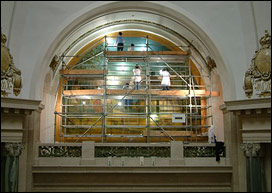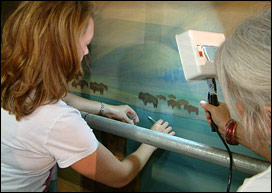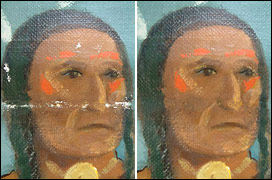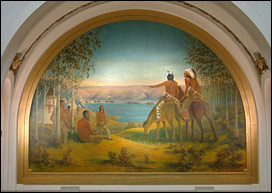Restoration of John Leman’s Mural: When the White Man Came, 1933








The mural, Before the White Man Came, is a familiar and much-loved painting positioned prominently in the rotunda of the Saskatchewan Legislative Building, Regina, Saskatchewan, Canada. Painted in 1933 by civil servant John Leman, the oil on canvas mural celebrates the life of the First Nations people in Saskatchewan just prior to the arrival of European settlers. After 71 years without maintenance, the mural was restored in 2005 as part of the Saskatchewan Centennial celebrations.
Conservators examined the mural using raking light and ultraviolet fluorescence to reveal conditions and determine course of treatment. Tiny cross sections of the painting were prepared and examined microscopically. Analysis revealed that the artist likely used commercial oil paints beginning with a thick ochre colored ground layer. Neither ultraviolet fluorescence nor microscopic examination indicated the presence of a varnish layer. Cleaning tests were carried out several months before treatment and at the time of treatment.
The painting appeared indistinct and dingy from thick dirt and grime, particularly in the top half. A dark vertical stain of dirt was present at top right from water drips that occurred decades ago. Marks and accretions such as wall-paint spatters were visible in a few locations and there was graffiti near the bottom at the signature. The two horizontal canvas seams of the mural were thickly filled in some places and over-painted with a poorly matched paint that was visually disturbing. A small square of painting at center bottom was very visible due to the fact it had been removed at some point and repaired by overfilling and overpainting. Paint was cracked, flaking and lifting from several areas of the painting, and, more important, the canvas was delaminating from the wall due to embrittlement of the adhesive. The wall itself was crumbling in localized areas due to moisture absorption.
Conservation of the mural took place between September and November of 2005, on-site, on scaffold by a crew of conservators from Fraser Safford Ricci Art & Archival Conservation Inc. (Principal Conservators Sarah Spafford-Ricci and Tara L. Fraser). The project was documented in written form and on digital media. Diagrams were made to record condition and various treatment locations.
The first stage was to clean the mural by brush into a vacuum nozzle to remove a large amount of dust and loose dirt. Dry-surface cleaning was then carried out using Chemsponges to remove lightly bound dirt and grime. After testing many different cleaning solvents, it was decided to use saliva on swabs for its gentle nature and negligible toxicity. Stubborn accretions required removal with scalpels and other mechanical tools. Overfill and overpaint was removed from seams and at an old repair at center bottom using scalpels micro-files and an ethanol containing cleaning gel.
Crumbling wall behind the canvas was excavated and then the holes were filled using Synkaloid wall spackle. Lifted and delaminated canvas was re-adhered using either BEVA Gel with hand pressure or using 1:1 BEVA 371 in VM & P naptha, heat-set. Areas of flaking and unstable paint were consolidated with BEVA 371 3:1 in VM & P naptha or Acryloid B72 7% in xylene. To reduce the appearance of the thick canvas seams, excess fill and canvas were removed and the remainder textured using scalpels and micro-files. On exposed canvas, areas were sized prior to inpainting with 7% Acryloid B72 and thinly primed with Winsor and Newton acrylic gesso by brush. Textural filling for paint losses and at seams was done using Mowiol GE-486 and calcium carbonate. Inpainting was done using Gamblin Conservation Colours in 3:1 isopropanol and Shell MS 145. The mural, although originally unvarnished, required a varnish to protect the extremely lean surface and prevent further absorption of dirt. Acryloid B72 7% in xylene, toluene and 1-methyl 2-propanol was applied in three thin passes by Apollo HVLP sprayer.
Cleaning, repair and restoration of the historic mural Before the White Man Came took almost 100 person days but resulted in a brighter and more stable painting, restored and preserved from surface harm with a protective varnish. Future maintenance will include removal of surface dust and examination by a conservator every five years to monitor continued integrity of the canvas and the wall.
